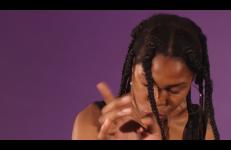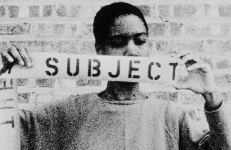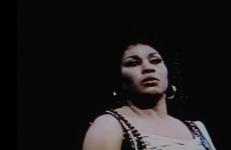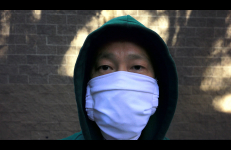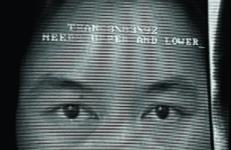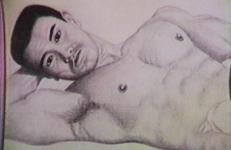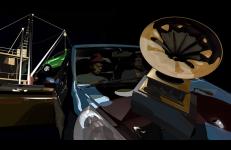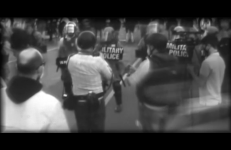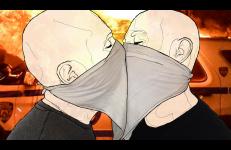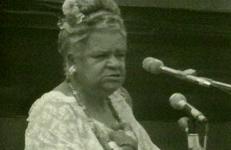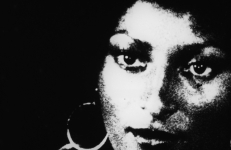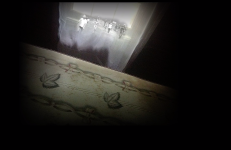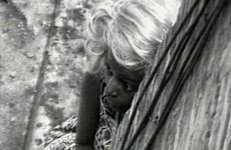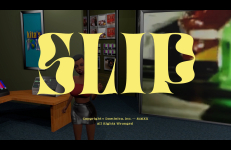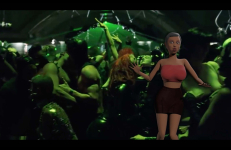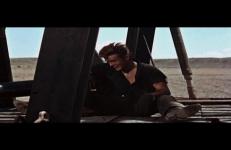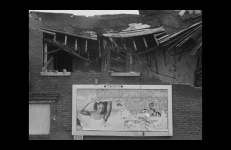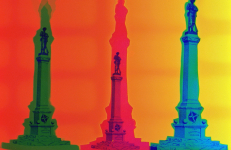“The roles that we construct are constructed because we feel that they will help us to survive and also, of course, because they fulfill something in our personalities; and one does not, therefore, cease playing a role simply because one has begun to understand it. All roles are dangerous. The world tends to trap and immobilize you in the role you play; and it is not always easy—in fact, it is always extremely hard—to maintain a kind of watchful, mocking distance between oneself as one appears to be and oneself as one actually is.”
Race
Inspired by a riff on a popular joke “Everybody wanna be a black woman but nobody wanna be a black woman,” Notes On Gesture is a video comparing authentic and dramatic gestures. The piece uses the 17th Century text Chirologia: Or the Natural Language of the Hand as a guide to create an inventory of gestures for performance. The piece alternates between title cards proposing hypothetical situations and short, looping clips that respond. The actor uses her body to quote famous, infamous, and unknown women.
An experimental investigation into the use of race as an arbitrary signifier. Drawing upon language, personal memories and the 1959 text, Black Like Me, it deals with Lacan’s “mirror state” theories of beauty and the movement from object to subject.
In 1985 the great soprano Leontyne Price sang the title role in Verdi’s Aida as her farewell opera. After the ‘O patria mia’ aria, the audience breaks into a four-minute applause. Oh My Homeland is the third in a series of minimal single shot 16mm films. It’s a film about representation, art, and material exchange. It’s a film about endings. It’s a film about identity, love, power, patriotism and the transcendent potential of art through the viewing of a face receiving adoration.
A childhood experience is projected on a shadowy wall of a former movie theatre. A racist cinematic trauma passed between friends and family is remembered among the rustling of leaves and reflections of trees on an iPad screen. An essay about how past and present interrupt one another like movies being perpetually edited.
The artist visits with seven cosmetic surgeons specializing in blepharoplasty (cosmetic eyelid creasing surgery) in the West Hollywood/Beverly Hills area for initial consultation sessions. The doctors demonstrate different reshaping options and comment upon the prevalence and success rates for different Asian nationalities while Tran presents statistics and facts in text that frame the consultations.
This title is also available on Tran, T. Kim-Trang: The Blindness Series.
In response to the dominant impression that gay people are white people, Orientations aims to set the record straight on homosexual identity. More than a dozen men and women of different Asian backgrounds speak frankly, humorously, and often poignantly about their lives as members of a minority within a minority. They speak about coming out, homophobia, racism, cultural identity, sex, and the ways that being gay and Asian have shaped who they are.
Hurricane Katrina and the ensuing aftermath destroyed Noel's community and home. He is rebuilding, and as he rebuilds, he evokes the past through the enlistment of his personal archives. His memories are complicated by the tragic events that occurred on the Danziger Bridge on September 4th 2005. As Noel reflects back on what has been lost, the story that he tells about his neighborhood is affected by the story of innocent people gunned down while attempting to cross a bridge in search of safety, and for Noel their plight clarify many things.
“A documentary about the Arkestra, but it's one whose presentation reflects the multilevel approach Sun Ra had to music and life in general. Jump cuts and split screens dot the visual stream with home movie footage from the Arkestra in Egypt during the 1970s to the Arkestra of today led by Marshall Allen. Director Ephraim Asili wisely divides the 40 minutes into distinct chapters, illustrating each with band interviews, live footage, visuals of planets and NASA launches, and his voice quoting writings from Ra.
Primavera is a frenetic experimental animation that documents the pandemic and the Black Lives Matter protests as they intersect in springtime Brooklyn. Shot during isolation on a phone, the video explores the effects of imposed distance on touch and intimacy, the proximity of an invisible virus and invisible deaths, and the revolt against the racist, corrupt systems that commodify, exploit and render their most vulnerable citizens disposable.
Two years after the riots and deaths at Attica, New York, a community day was organized at Greenhaven, a federal prison in Connecticut. Think Tank, a prisoners' group, coordinated efforts with African-American community members outside the prison walls to fight racism and poverty. The event was documented by People's Communication Network, a community video group founded by Bill Stephens, for cablecast in New York City, marking the first time an alternative video collective was allowed to document an event inside prison walls.
Taking its name from the Jim Crow-era of black criminals staring at white women, this hand-processed, optically-printed amalgam reframes desire by way of everything from D.W. Griffith to Foxy Brown and Angela Davis: 'Your lover belongs to this band of murderous outlaws.'
–– Cinematexas International Short Film Festival
This version of the film is a 2K restoration made by the Academy Film Archive in 2022.
In response to BLM events and to the whole world of injustice, slaughter and abuse... a small comment.
–– Ken Kobland
Loosely based on the 1950s British detective film Sapphire, in which two Scotland Yard detectives investigate the murder of a young woman who is passing for white, Sapphire and the Slave Girl examines the determinants of Sapphire's murder investigation through its cinematic representation.
Second and Lee is a cautionary tale about when not to run. It uses archival reportage and voiceover recollection to trace through repetitive corridors of presumption, justice and judgment.
Slip is from Martine Syms’ Kita’s World series. Kita enacts the performances of everyday life in a hyper-digitized world. The character’s roles range from meditation guru to cultural commentator, and she speaks directly to questions of consciousness within the systems of labor, race, technology, and institutional failure. To the cognitive dissonance of Siri mishearing her speech, to the terror of (mis)representation, to the instinct to reconnect with nature.
Soliloquy is from Martine Syms’ Kita’s World series. In the series, Kita enacts the performances of everyday life in a hyper-digitized world. The character’s roles range from meditation guru to cultural commentator, elaborating on questions of race, gender, and technology prevalent throughout the artist’s practice. In these video works, Syms creates an environment in which being human is inextricably linked to the impact and interruptions of technological innovation.
Something Else is a film about found footage as subject matter and Miss Black Roanoke, Virginia 1971 expressing her thoughts about the upcoming Miss Black Virginia 1971 Pageant.
Cast: Rene Marie.
This title is only available on Broad Daylight and Other Times: Selected Works of Kevin Jerome Everson.
A fable-like tale, Splash explores the interplay between identity, fantasy, and homosexual desire in pre-adolescence within the narrow confines of black masculinity. The tape is an exploration of the filmmaker’s psycho-social and sexual development within a society that encourages the consumption of whiteness and heterosexuality. Splash reveals how the family becomes the agency through which sexual repression and gender conformity are carried out.
Sportello Quattro, filmed during a residency at the American Academy in Rome, is about immigration, work and community among people of color in contemporary Rome, Italy.
Cast: Joseph Bayorha.
This title is only available on Broad Daylight and Other Times: Selected Works of Kevin Jerome Everson.
stammering forward backward GIANT is a re-edit of George Stevens' 1956 film Giant - an epic story of Texas, oil and racism. Condensed to 17 minutes and beginning in the middle, stammering forward backward GIANT implements improvisational percussive frame by frame editing structures to simultaneously unwind the film to the conclusion of beginning and end.
still/here is a meditation on the vast landscape of ruins and vacant lots that constitute the north side of St. Louis, an area populated almost exclusively by working class and working poor African Americans. Though it constructs a documentary record of blight and decay, still/here is a refusal of closure that dwells within the space of rupture and confronts the presence of a profound absence.
–– Christopher Harris
Camera, sound, edit: Christopher Harris
Additional camera: Joel Wanek
Ever listen to Loveline? Well, here's an episode with a 24-year-old Korean American guy who's never been kissed. They're offering free concert tickets to any girl who'll come in and take a chance. The girls get their tickets, and "David" gets to pick one of them for his first smack. Trouble is... no volunteers. Combining personal dating stories and the hypnotic imagery of multi-colored koi, Sweet Or Spicy? explores Hapa and Asian American male sexuality in popular culture.
Statement
A last stand for the silent guardians of the old order. Take It Down is a filmic day of reckoning for the Old Confederate South. What is up must come down, like the Confederate soldier monuments standing in court house squares across the South. At long last, a grand inversion! Solarized film makes positives bleed into negatives. The South is renewed.
This film looks to North Carolina to describe the cultural fissure that runs through the South, a legacy of the Civil War. In the context of the divisive Trump presidency and the increasing visibility of white supremacist activism, these Confederate memorials have become sites of conflicting politics and historical narratives.
Historians agree that a majority of Confederate statues were erected as propaganda tools legitimizing racism in the era of Jim Crow laws. For example, “Silent Sam”, a statue depicted in the film, was erected on the quad of the University of North Carolina campus. In an act of civil disobedience in Fall 2018, students and protestors tore down the statue in a statement against white supremacist oppression.





